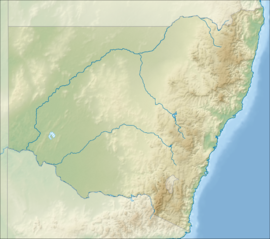Albury, Australia
|
Albury New South Wales |
|||||||||
|---|---|---|---|---|---|---|---|---|---|

The city of Albury as seen from Monument Hill
|
|||||||||
| Coordinates | 36°04′50″S 146°54′57″E / 36.08056°S 146.91583°ECoordinates: 36°04′50″S 146°54′57″E / 36.08056°S 146.91583°E | ||||||||
| Population | 47,974 (2016 census) | ||||||||
| Established | 1839 1946 (city) |
||||||||
| Postcode(s) | 2640 | ||||||||
| Elevation | 165.0 m (541 ft) | ||||||||
| Time zone | AEST (UTC+10) | ||||||||
| • Summer (DST) | AEDT (UTC+11) | ||||||||
| Location |
|
||||||||
| LGA(s) | City of Albury | ||||||||
| County | Goulburn | ||||||||
| State electorate(s) | Albury | ||||||||
| Federal Division(s) | Farrer | ||||||||
|
|||||||||
| Mayor of Albury | |
|---|---|
|
Incumbent
Kevin Mack since 10 September 2016 |
|
| Style | Councillor |
| Member of | Albury City Council |
| Formation | 1859 |
| First holder | James T Fallon |
Albury, /ˈɔːlbəri/ a major regional city in New South Wales, Australia, is located on the Hume Highway and the northern side of the Murray River. It is the seat of local government for the council area which also bears the city's name the City of Albury.
Albury has an urban population of approximately 48,000 as at the 2016 Census and is separated from its twin city in Victoria, Wodonga, by the Murray River. Together, the two cities form an urban area with a population of approximately 89,000 as at the 2016 Census. It is 554 kilometres (344 mi) from the state capital Sydney and 326 kilometres (203 mi) from the Victorian capital Melbourne.
Said to be named after a village in England, Albury developed as a major transport link between New South Wales and Victoria and was proclaimed a city in 1946.
The first peoples were the Wiradjuri people occupied this area, (Wiradjuri northern dialect pronunciation [wiraːjd̪uːraj]) or Wirraayjuurray people (Wiradjuri southern dialect pronunciation [wiraːjɟuːraj]) are a group of Indigenous Australian Aboriginal people that were united by a common language, strong ties of kinship and survived as skilled hunter–fisher–gatherers in family groups or clans scattered throughout central New South Wales.
In the 21st century, major Wiradjuri groups live in Condobolin, Peak Hill, Narrandera and Griffith. There are significant populations at Wagga Wagga and Leeton and smaller groups at West Wyalong, Parkes, Dubbo, Forbes, Cootamundra, Cowra and Young.
...
Wikipedia

